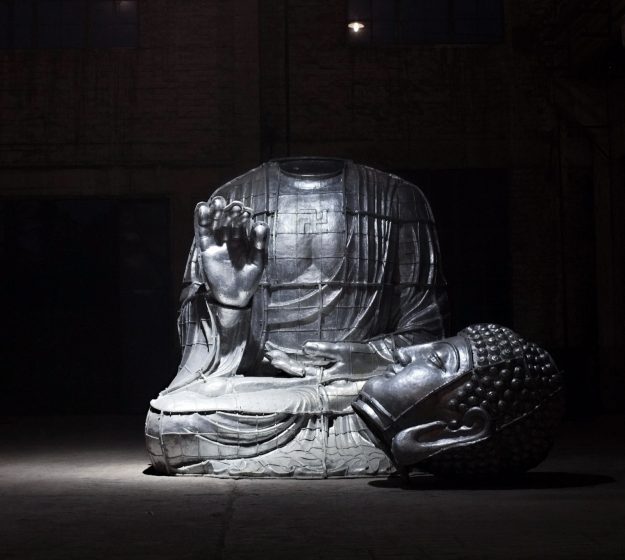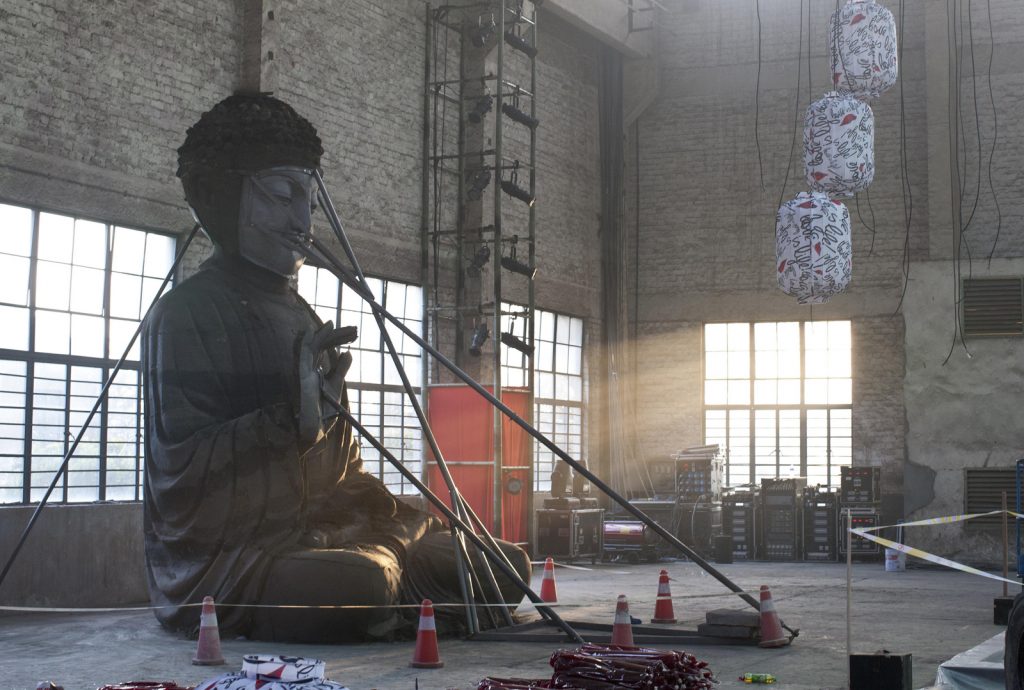This review is a response to Secularizing Buddhism: New Perspectives on a Dynamic Tradition, a book around which Tricycle previously hosted a four-part event series. Watch discussions from the series here on YouTube.
Anyone picking up Secularizing Buddhism should first turn to the editor’s concluding chapter, where Richard K. Payne unfurls his intention to “interrogate” something called “the secularizing discourse” (singular). At a normal interrogation, the interrogatee is present in the room. But not in this case. Thus the interrogation segues into the prosecutor’s opening address, with the defendant on trial in absentia and unrepresented. An inevitable collapse of evidentiary and forensic standards follows.
Secularizing Buddhism: New Perspectives on a Dynamic Tradition
edited by Richard K. Payne
Shambhala Publications, March 2021, 360 pp., $24.95 (paper)
The main charge has it that the secularizing discourse (let’s call it SD) constitutes the delayed rebirth of the 16th-century Protestant Reformation. It carries all the defilements of its former incarnation—textual fundamentalism, anticlericalism, individualism, disrespect for religious authority, abhorrence of ritual, complicity with colonialism, and what the German sociologist Max Weber called “the rationalization and disenchantment of the world.” But SD also embodies distinctly late-modern inclinations such as Orientalist disdain, hostility toward tradition, insistence that the Buddha was human, (invisible) whiteness, racism, empiricism, dogmatism, neoliberal manipulation, conservatism, and the neocolonial project.
However, SD is an abstraction, a sort of street gang, and the public will want to see actual villains occupying the dock. So which villains are we actually talking about? Two stand out in this collection. The first is “the mindfulness movement” (singular) whose practitioners the scholar and dharma teacher Ron Purser identifies as “Secular Buddhists” in his contribution. They are “the new scientifically authorized mindfulness priests” who use the confessional mode to mold their subjects into “ideal neoliberal selves.”
The second culprit is Stephen Batchelor, the contemporary teacher known for his agnostic approach to Buddhism, who makes fleeting appearances throughout the collection, rather like the specter haunting Europe in the first sentence of the Communist Manifesto. He disturbs the sleep of good Buddhists by night. And that’s about all we learn about him until we come to contributor Philippe Turenne’s “friendly invitation” to have a conversation with him.
Turenne, a Canadian scholar based in Kathmandu, says he wants to quiz Batchelor about his attempt to impose a new orthodoxy on the Buddhist world, one that is empiricist (Batchelor’s “love of empiricism” rates two mentions) and informed by his dislike of Buddhism, skepticism about the tradition, disrespect for the Abhidhamma, dry scholarship, naturalistic/psychological conception of liberation, rationalism, positivism, scientism, and other “modern ideologies.” Turenne adduces no evidence for these attributions. That’s understandable—there’s none to be had.
Turenne has lost sight of the division in Western philosophy’s development from the late 19th century, with a post-metaphysical branch (including phenomenology, existentialism, and pragmatism) diverging from an analytical branch (including positivism and empiricism) that has meanwhile converged with the natural sciences. Generations of thinkers, now including Batchelor, have leveraged the dharma’s affinity with phenomenology in particular, as both prioritize direct experience. Turenne has simply stalked Batchelor along the wrong branch, and mistaken a concern with experience for empiricism. On that basis every vipassana or insight meditator would also be an empiricist, not to mention the Buddha himself.
Turenne’s clumsy juggling of concepts typifies much of the argumentation in this collection. Key terms like religion, tradition, secularism/secularity, and even Buddhism are tossed around as if their meanings were self-evident and uncontested, each one sealed off from further inquiry with an initial capital letter. For example, almost all the contributors except Sarah Shaw assume that Secularity is the antithesis of Religion, yet many writers on secularity (including secular Buddhists) see it in terms of its actual etymology, as a reference to specific times and places, with no necessary connection to religion. In his magisterial text in this area, A Secular Age (2007), the Canadian philosopher Charles Taylor presents secularity as the achievement of Western religious culture over the last seven centuries.
To take another example, contributors who adhere to the collection’s editorial line fulminate against secular Buddhists’ disrespect for the Buddhist Tradition. But as philosopher Alasdair MacIntyre has pointed out in his important work After Virtue (1981), a living tradition is one in which each generation goes back to the beginning, to the founder’s original questions, in an intergenerational conversation, a process of renewal. By contrast, “the Tradition” most contributors to this volume defend is what MacIntyre calls a “sedimented,” “dying,” or already “dead” one, in which the current generation simply rehearses whatever it’s been inducted into, with scant sense of how present practice came about and why. From this point of view, Batchelor and others are carrying on the Buddha’s living tradition and are thus the true traditionalists.

Suggesting guilt by association is an important ploy in the prosecution’s case in this book. It explains the awkward and unfamiliar title “Secularizing Buddhism,” which along with “the Secularizing Discourse” casts a wide net indeed. Potentially it squeezes self-describing secular-Buddhist dharma and meditation teachers into the same dock as the worst commercializers, corporatizers, and militarizers of mindfulness meditation, whom Ron Purser catalogs in his own book, McMindfulness (2019). It’s as if the former collude in the devilment of the latter. But sometimes the ploy needs some expert backup.
Lawyers who run cases through courts, though, attest to the high risk of calling expert witnesses. Under gentle cross-examination from the other side, experts often stray from the narrative they’re supposed to support—or actually disrupt it, as they steer the discussion toward their own professional insights. The valuable chapters in this collection are of this ilk, and make it worth getting, in spite of the editorial agenda.
Sarah Shaw’s suggestion that secular Buddhism has become religious lacks backing. But she does take us into the important shifts in the Theravada from the late 19th century. They fed into Buddhist modernism, and eventually into the various strands of the current Western Vipassana movement. Kate Crosby’s chapter complements Shaw’s, with a detailed examination of how imperial pressures and national exigencies shaped Theravada developments in Burma, including secular ones, leading up to heresy trials in late 20th-century Myanmar. (Yes, Buddhist heresy trials, ending in prison sentences!) Kathleen Gregory (for whom “secular Buddhism” means mindfulness meditation) teases out some interesting themes in the area, starting with the work of Jon Kabat-Zinn.
The valuable chapters in this collection make it worth getting, in spite of the editorial agenda.
A drastic change in the conditions of belief characterizes the present secular age, Charles Taylor argues: we can no longer naively cleave to any doctrine as absolutely true and beyond challenge. We now have to take responsibility for our choice of belief. Theravada teacher Bhikkhu Bodhi does just that in his confessional chapter, in which he straightforwardly commits to all the truth claims of orthodox Theravada as the opposite pole to secular Buddhism. (At the same time, he points to the cylinder that fails to fire across the Buddhist spectrum: civic engagement around humanity’s two main crises today—global warming and social injustice.)
The reader can contrast Bhikkhu Bodhi’s embrace of the supernatural with Roger Jackson’s amusing survey of how Buddhists of various persuasions—literalist, neotraditionalist, modernist, and secularist—handle the hot potato of rebirth doctrine. Once again we have to choose: to believe in rebirth literally, more or less literally, figuratively, or not at all.
The best contributions in this collection come from the tacit disruptors of its editorial line, David McMahan and Gil Fronsdal. The former leads us through a subtle and complex account of the travails of modern subjectivity, now further impacted by mindfulness practices. For both the maestros and those who sit at their feet, the experience of mindfulness can lead either to a false sense of individualistic autonomy (the neoliberal delusion) or, through an experience of not-self, to a dharmic illumination of interdependence and interbeing. Depending on context, then, secular mindfulness has a liberatory potential.
Fronsdal’s chapter is another limpid confession of faith, in the Theravada tradition like Bhikkhu Bodhi’s, but on radically different premises. Although he is a vipassana teacher in the Mahasi lineage, Fronsdal identifies as a “naturalistic” Buddhist—an increasingly popular identity in the West. Natural Buddhism involves expounding the dharma and teaching meditation exclusively on the basis of natural—as opposed to supernatural—doctrine and guidelines. In doing so, Fronsdal writes, he’s merely following the example of the Buddha, for whom dharma practice marginalized supernatural concerns. He acknowledges a close affinity with secular Buddhism but feels that the label itself is an oxymoron because, for him, Buddhism is a religion.
Still, the problem of the editorial intention driving Secularizing Buddhism remains: to defend that old-time religion from the barbarians at the gate. I read it at the same time as I was reading Svetlana Boym’s The Future of Nostalgia (2001), where I came across this passage:
Modern nostalgia is a mourning for the impossibility of mythical return, for the loss of an enchanted world with clear borders and values; it could be a secular expression of a spiritual longing, a nostalgia for an absolute, a home that is both physical and spiritual, the edenic unity of time and space before entry into history.
And the thought arose in me: Hmm.
Thank you for subscribing to Tricycle! As a nonprofit, we depend on readers like you to keep Buddhist teachings and practices widely available.
